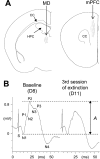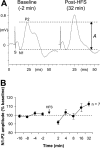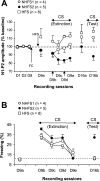Prefrontal cortex long-term potentiation, but not long-term depression, is associated with the maintenance of extinction of learned fear in mice
- PMID: 11784805
- PMCID: PMC6758664
- DOI: 10.1523/JNEUROSCI.22-02-00577.2002
Prefrontal cortex long-term potentiation, but not long-term depression, is associated with the maintenance of extinction of learned fear in mice
Abstract
Considerable efforts have been made to identify changes of brain synaptic plasticity associated with fear conditioning. However, for both clinical applications and our fundamental understanding of memory processes, it appears also necessary to investigate synaptic plasticity related to extinction. We previously showed that extinction of freezing to a tone conditioned stimulus (CS; previously paired with footshock) in mice results in a sequence of depression and potentiation of synaptic efficacy in the medial prefrontal cortex (mPFC). These data as well as those from lesion studies suggest that the direction of changes in prefrontal synaptic plasticity may modulate extinction of learned fear. To test this, we analyzed the effects of low-frequency stimulation (LFS) and high-frequency stimulation (HFS) of the mediodorsal thalamic nucleus, known to induce prefrontal long-term depression (LTD) and potentiation (LTP), respectively, on extinction. We found that maintenance of the depression phase, using thalamic LFS, was associated with resistance to extinction. Thalamic HFS applied before extinction testing had no effect on the rate of extinction. However, 1 week follow-up tests revealed that the memory of extinction was intact in these mice (with prefrontal LTP) and in control mice displaying prefrontal LTP-like changes, whereas control mice that did not exhibit such changes displayed a return of freezing to the CS. The results suggest that after extinction the lack of depression-LTP-like conversion sequence in the mPFC synaptic efficacy may profoundly alter the process of consolidation.
Figures




Similar articles
-
Plasticity in the mediodorsal thalamo-prefrontal cortical transmission in behaving mice.J Neurophysiol. 1999 Nov;82(5):2827-32. doi: 10.1152/jn.1999.82.5.2827. J Neurophysiol. 1999. PMID: 10561450
-
Reorganization of learning-associated prefrontal synaptic plasticity between the recall of recent and remote fear extinction memory.Learn Mem. 2007 Aug 1;14(8):520-4. doi: 10.1101/lm.625407. Print 2007 Aug. Learn Mem. 2007. PMID: 17671108 Free PMC article.
-
Electrolytic lesions of the medial prefrontal cortex do not interfere with long-term memory of extinction of conditioned fear.Learn Mem. 2006 Jan-Feb;13(1):14-7. doi: 10.1101/lm.60406. Epub 2006 Jan 17. Learn Mem. 2006. PMID: 16418435 Free PMC article.
-
Prefrontal mechanisms in extinction of conditioned fear.Biol Psychiatry. 2006 Aug 15;60(4):337-43. doi: 10.1016/j.biopsych.2006.03.010. Epub 2006 May 19. Biol Psychiatry. 2006. PMID: 16712801 Review.
-
Medial prefrontal cortex: multiple roles in fear and extinction.Neuroscientist. 2013 Aug;19(4):370-83. doi: 10.1177/1073858412464527. Epub 2012 Oct 22. Neuroscientist. 2013. PMID: 23090707 Review.
Cited by
-
Classical conditioning in borderline personality disorder: an fMRI study.Eur Arch Psychiatry Clin Neurosci. 2016 Jun;266(4):291-305. doi: 10.1007/s00406-015-0593-1. Epub 2015 Mar 27. Eur Arch Psychiatry Clin Neurosci. 2016. PMID: 25814470
-
Bidirectional Optogenetically-Induced Plasticity of Evoked Responses in the Rat Medial Prefrontal Cortex Can Impair or Enhance Cognitive Set-Shifting.eNeuro. 2020 Jan 6;7(1):ENEURO.0363-19.2019. doi: 10.1523/ENEURO.0363-19.2019. Print 2020 Jan/Feb. eNeuro. 2020. PMID: 31852759 Free PMC article.
-
Selective modification of short-term hippocampal synaptic plasticity and impaired memory extinction in mice with a congenitally reduced hippocampal commissure.J Neurosci. 2002 Sep 15;22(18):8277-86. doi: 10.1523/JNEUROSCI.22-18-08277.2002. J Neurosci. 2002. PMID: 12223582 Free PMC article.
-
The L-type calcium channel blocker nifedipine impairs extinction, but not reduced contingency effects, in mice.Learn Mem. 2005 May-Jun;12(3):277-84. doi: 10.1101/lm.88805. Learn Mem. 2005. PMID: 15930506 Free PMC article.
-
Metabolic mapping of mouse brain activity after extinction of a conditioned emotional response.J Neurosci. 2003 Jul 2;23(13):5740-9. doi: 10.1523/JNEUROSCI.23-13-05740.2003. J Neurosci. 2003. PMID: 12843278 Free PMC article.
References
-
- Blanchard RJ, Blanchard C. Crouching as an index of fear. J Comp Physiol Psychol. 1969;67:370–375. - PubMed
-
- Davis HP, Squire LR. Protein synthesis and memory: a review. Psychol Bull. 1984;96:518–559. - PubMed
-
- Ettedgui E, Bridges M. Posttraumatic stress disorder. Psychiatr Clin North Am. 1985;8:89–103. - PubMed
Publication types
MeSH terms
LinkOut - more resources
Full Text Sources
Other Literature Sources
